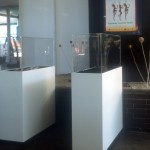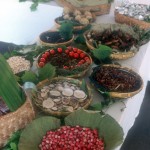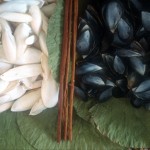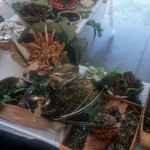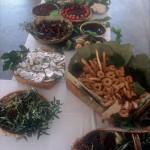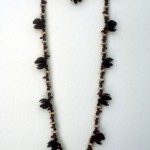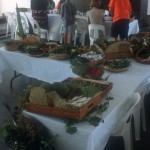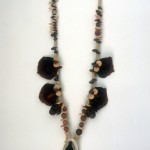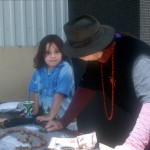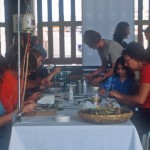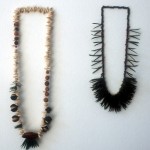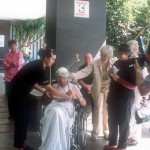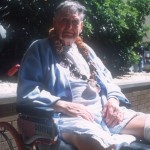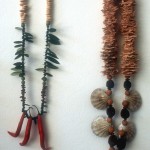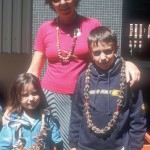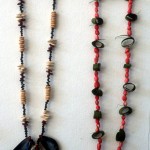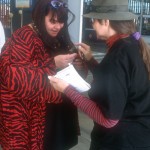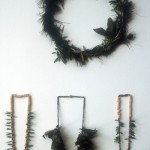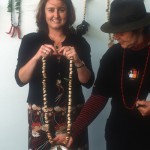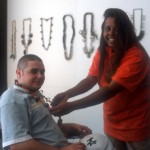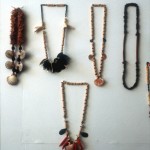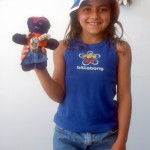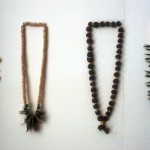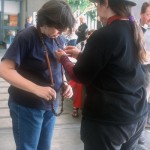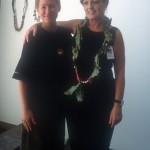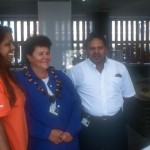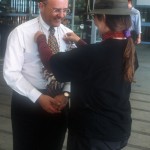Adelaide Festival 2002
held at The Queen Elizabeth Hospital
as part of the Nourish programme at the Hospital
The Edible Lei
(co-ordinated by artist /associate director of Adelaide Festival Lynette Wallworth)
Gay Bilson (chef/associate director of Adelaide Festival) – concept
Sieglinde Karl (visual artist) – artistic interpretation
participating artists: Maria-Jane Ryan Bennett – jeweller
Susie Betts – indigenous artist
volunteers
Emma Grace – jeweller
Ray Cockram
Jan Daly
Sue Mudge – jeweller
This project was also funded and assisted by Greening Australia and the Botanic Gardens of Adelaide
This five day residency was the culmination of months of collaboration between the artist and those who shared their knowledge of indigenous and exotic food plants and their seeds, Adelaide Botanic Gardens, Greening Australia. During the festival, volunteer jewellers from the Jam Factory and Underdale School of Art gave their time. As one of the associate directors of the 2002 Festival, I had a particular interest in asking artists to address edible culture and had put the idea to Sieglinde, whose beautiful, celebratory work had been part of a major exhibition of craft in 2001 at the Art Gallery of South Australia. Peter Sellars had impressed on us that this Festival would be like a camp, a socially inclusive place where everyone needed to contribute and participate to make it work, that cultural resilience was central to its concerns, that what one experienced during the Festival would be a shared work in progress, an open-ended conversation, the impetus for more ideas.
excerpt from an essay by Gay Bilson
Tasmanian artist Sieglinde Karl has taken up Gay Bilson’s challenge to make leis from edible seed pods and other foods, both indigenous and exotic. Two prototypes for the Festival project are already on temporary display at the new Queen Victoria Museum & Art Gallery site at Inveresk, Launceston, Tasmania.
The Undercroft area at the main entrance to the hospital will become a public workshop where Sieglinde with the help of other jewellers will work toward a collection of leis which will be given as part of the closing ceremony of the Festival. The artists leis will also be exhibited at the workshop for the 5 day residency . Central to this project is an invitation to the public to join the artists and thread their own, and then to make a gift of their lei. Leis are symbols of welcome, friendship and affection and are always given. The Edible Lei is a symbol of generosity and nourishment, of sharing, celebration and reconciliation. It is an offering. The project includes the collection of the materials from many parts of South Australia and pays tribute to the Aboriginal women from these areas whose knowledge has informed the making of the leis. The Edible Lei is a threading of cultural and culinary memory.
The Adelaide Festival 2002: A war zone of real and imagined differences of opinion over definitions of audience and ownership. The eventual assassination of the artistic director by a powerful and subconsciously, at the very least, racist faction of money and conservatism. A bullying, complicitous media which refused the invitation to a program which held that the arts play a pivital role in addressing issues of social justice. Impolite, Peter Sellars suggested that the arts might be shared and participated in, that performances, and the presence of artists, make the stretch to the ‘wrong’ inclusive places: Victoria Square transformed to its legitimate sacred presence as Tarndanyunga where Kuarna people, with respect, welcomed people from other lands, a community centre in a suburb besieged for lack of opportunity, the Maralinga Tjarutja people of Oak Valley, Tauondi Aboriginal College in Port Adelaide and, among more, the most forbidden site, a public hospital.
The Queen Elizabeth Hospital: Adelaide’s largest public hospital, geographically and culturally so far away from the Arts precinct as defined by North Terrace, the Art Gallery, the Festival Centre, to make it an unimaginable place to host artists and performance. Yet, think about it, the most obvious place to acknowledge the role that the artist plays in our sense of well being, indeed in healing, through imaginative leaps. This hospital serves, despite dire funding problems, a plural and multicultural community, including a very large number of indigenous people with diabetes.
- today in the garden at Bundeena
